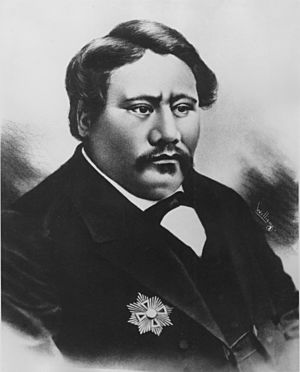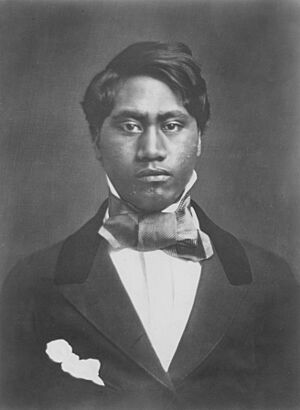Kamehameha V facts for kids
Quick facts for kids Kamehameha V |
|||||
|---|---|---|---|---|---|
 |
|||||
| King of the Hawaiian Islands (more...) | |||||
| Reign | November 30, 1863 — December 11, 1872 | ||||
| Predecessor | Kamehameha IV | ||||
| Successor | Lunalilo | ||||
| Kuhina Nui | Victoria Kamāmalu, Kaʻahumanu IV Kekūanāoʻa |
||||
| Born | December 11, 1830 Honolulu, Oahu |
||||
| Died | December 11, 1872 (aged 42) Honolulu, Oahu |
||||
| Burial | January 11, 1873 Mauna ʻAla Royal Mausoleum |
||||
| Issue | Keanolani | ||||
|
|||||
| House | House of Kamehameha | ||||
| Father | Kekūanāoʻa Ulumāheihei Hoapili (hānai) |
||||
| Mother | Kīnaʻu Nāhiʻenaʻena (hānai) Kalākua Kaheiheimālie (hānai) |
||||
| Religion | Church of Hawaii | ||||
| Signature | |||||
Kamehameha V (born Lota Kapuāiwa Kalanimakua Aliʻiōlani Kalanikupuapaʻīkalaninui; December 11, 1830 – December 11, 1872) was the fifth monarch of the Kingdom of Hawaiʻi. He ruled from 1863 to 1872. His personal motto was "Onipaʻa," which means "immovable," "firm," or "determined." He worked hard for his people and his kingdom. Many described him as the last great traditional Hawaiian chief.
Contents
Early Life and Education
Lot Kapuāiwa was born on December 11, 1830. His mother was Elizabeth Kīnaʻu and his father was Mataio Kekūanāoʻa. He had several siblings, including David Kamehameha, Moses Kekūāiwa, Alexander Liholiho, and Victoria Kamāmalu. He was also a grandson of Kamehameha I, a very famous Hawaiian king. The name Kapu āiwa means a sacred person protected by special powers.
Hawaiian Adoption Tradition
Lot was adopted using an old Hawaiian tradition called hānai. First, he was adopted by Princess Nāhiʻenaʻena, but she passed away in 1836. Then, his grandmother Queen Kalākua Kaheiheimālie and step-grandfather High Chief Ulumāheihei Hoapili adopted him. This tradition sometimes made children feel like strangers in their new homes.
Schooling and Travel
Since King Kamehameha III chose him as a possible heir to the throne, Lot was educated at the Royal School. He studied there with his cousins and siblings. When he was born, he was promised in marriage to Bernice Pauahi. However, she later chose to marry an American named Charles Reed Bishop instead.
After finishing school, Lot traveled abroad with his brother Alexander Liholiho. They sailed to San Francisco in 1849. After visiting California, they continued their journey to Panama, Jamaica, New York City, and Washington, D.C.. They also toured Europe and met important leaders like French president Louis Napoleon and British prince consort Albert. In the United States, they met President Zachary Taylor and Vice President Millard Fillmore.
Royal Career and Public Service
Lot Kapuāiwa held many important positions before becoming king. From 1852 to 1855, he served on the Privy Council of State. He was also a member of the House of Nobles from 1852 to 1862. He worked as the Minister of the Interior from 1857 to 1863. He even served as the chief justice of the supreme court for a year, from 1857 to 1858.
His younger brother, Alexander Liholiho, who was more outgoing, became King Kamehameha IV in 1854. In 1862, Lot was officially added to the line of succession. This meant that if his brother died without any children, Lot and his children would become the next rulers. This change happened just before the death of Prince Albert Kamehameha, who was the only son of Kamehameha IV.
Becoming King and New Laws
Lot became King Kamehameha V on November 30, 1863, after his brother passed away. He decided not to follow the previous constitution of 1852. He especially disliked the part of that constitution that allowed all men to vote for the House of Representatives.
Creating a New Constitution
In May 1864, King Kamehameha V called for a special meeting to discuss a new constitution. On July 7, 1864, he suggested writing a completely new constitution instead of just changing the old one. The meeting went smoothly until they reached article 62. This article suggested that voters should be able to read and write, own property, or have a certain income. On August 20, 1864, he signed the 1864 Constitution of the Kingdom of Hawaii and promised to protect it. This new constitution was based on his ideas, but 20 articles were removed.
When he appointed Charles de Varigny, a French person, as his finance minister in December 1863, some Americans in Hawaiʻi thought he was against them. However, his foreign policy actually stayed the same. Later, de Varigny became the minister of foreign affairs from 1865 to 1869.
Reviving Hawaiian Traditions
Kamehameha V was the first king to encourage the return of traditional Hawaiian practices. During his rule, laws against "kahunaism" (traditional Hawaiian practices and healers) were removed. A Hawaiian Board of Medicine was created, which included kahuna members. This allowed la'au lapa'au, or traditional Hawaiian medicine, to be practiced again. He even brought kahuna practitioners to Honolulu to write down their remedies.
In 1865, a law was proposed that would allow alcohol to be sold to Native Hawaiians. King Kamehameha V surprised everyone by saying, "I will never sign the death warrant of my people." He knew that alcohol could harm his people.
Increased Travel to Hawaii
More people started traveling to the Hawaiian Islands during Kamehameha V's reign. The famous writer Mark Twain visited in March 1866. He stayed for four months, writing letters about the islands for the Sacramento Union newspaper. Twain described the king:
He was a wise sovereign; he had seen something of the world; he was educated & accomplished, & he tried hard to do well by his people, & succeeded. There was no trivial royal nonsense about him; He dressed plainly, poked about Honolulu, night or day, on his old horse, unattended; he was popular, greatly respected, and even beloved.
Queen Victoria of Great Britain sent her second son, Prince Alfred, Duke of Edinburgh, for a state visit in 1869. King Kamehameha V also asked Kaiser Wilhelm I of Germany for help. The Kaiser sent Henri Berger to organize the Royal Hawaiian Band, which was a musical gift from the king to his people.
Succession and Legacy
His sister, Crown Princess Victoria Kamāmalu, was his only named heir. She passed away without children in 1866. Because of this, Kamehameha V did not name a successor for the rest of his reign. He died on December 11, 1872, which was also his birthday. As he was very ill, he told visitors, "The Good Lord cannot take me today, today is my birthday." He offered the throne to his cousin Bernice Pauahi Bishop, but she refused. He passed away an hour later without choosing an heir. He was buried in the Royal Mausoleum of Hawaii at Mauna ʻAla.
Kamehameha V was the last king from the House of Kamehameha to use the Kamehameha name. Before he died, he said:
The throne belongs to Lunalilo; I will not appoint him, because I consider him unworthy of the position. The constitution, in case I make no nomination, provides for the election of the next King; let it be so." Since he did not name an heir, the next king had to be chosen by the legislature. Kamehameha V's cousin, William Charles Lunalilo, who was also related to Kamehameha I through his mother, asked for a general election and won. The legislature agreed, and Lunalilo became the first elected King of the Hawaiian Kingdom.
Lasting Contributions
King Kamehameha V founded the Royal Order of Kamehameha I society on April 11, 1865. This group was created to honor his famous grandfather.
The Prince Lot Hula Festival is named after him. This festival has been held every third Saturday in July since 1977 at his former home, Moanalua Gardens.
Images for kids
See also
In Spanish: Kamehameha V para niños



